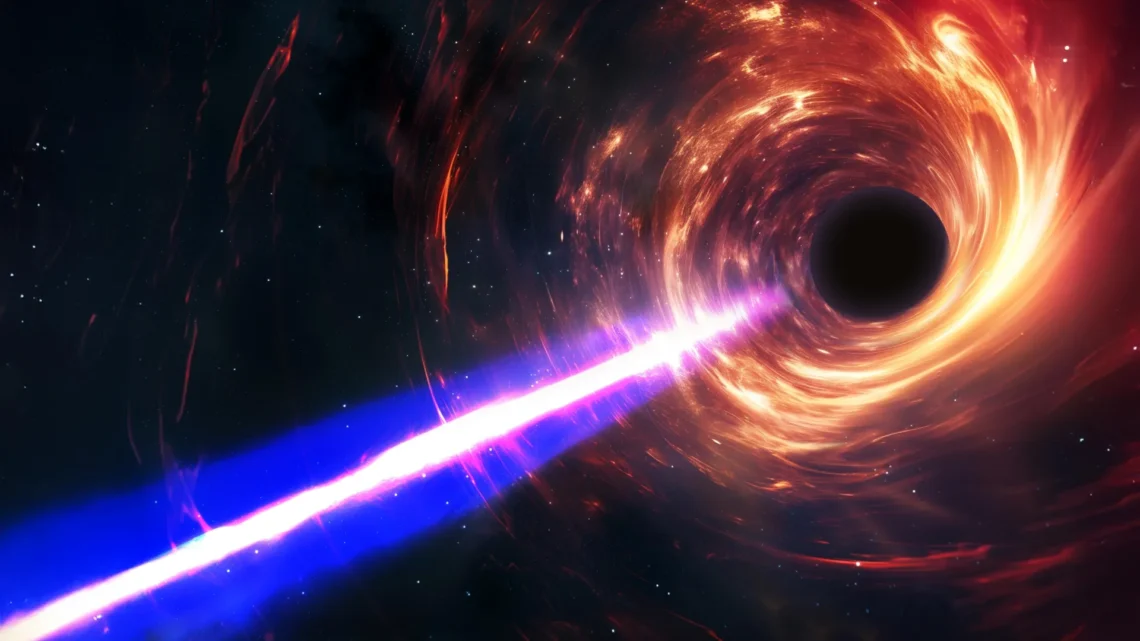Traditionally, black holes are thought to “reside” at the centers of galaxies. However, a research team led by Dr. AN Tao from the Shanghai Astronomical Observatory of the Chinese Academy of Sciences has uncovered a wandering black hole in a dwarf galaxy about 230 million light-years away (redshift z = 0.017).
Unlike typical black holes, this one isn’t located at the center of the galaxy. Instead, it’s nearly one kiloparsec away and is emitting radio jets. This off-center black hole, found in a nearby dwarf galaxy, is one of the closest and most convincing cases ever confirmed.
Published online in Science Bulletin on September 4, this discovery adds weight to the idea that black holes can grow outside of galactic centers, providing a new perspective on how supermassive black holes could have developed so rapidly in the early universe.
Black Holes Are Not Always in Galactic Centers
In our common view of the cosmos, black holes are usually seen as the “hearts” of galaxies. But increasing evidence shows that some black holes don’t stay nestled at the galactic core. Instead, they wander, drifting through the galactic disk or outskirts, just like lost travelers in the universe.
Why focus on dwarf galaxies? These galaxies are smaller and have simpler evolutionary histories. They function as “cosmic fossils,” preserving clues about the early development of black holes. The theory suggests that gravitational shocks from galaxy mergers can easily displace black holes, sending them wandering thousands of light-years away. Some simulations even indicate that a notable number of dwarf-galaxy black holes could be kicked out nearly a kiloparsec (about 3,000 light-years) from their centers. However, conclusive observational evidence has been lacking until now.
New Discovery: A “Radio-loud Wandering Black Hole” in a Dwarf Galaxy
Dr. AN and the team studied a dwarf galaxy named MaNGA 12772-12704, located about 230 million light-years from Earth (z ≈ 0.017). Using data from the Mapping Nearby Galaxies at Apache Point Observatory (MaNGA) survey, they found this galaxy shows weak active galactic nucleus (AGN) signatures. While it appears regular overall, one striking feature is that the radio emissions are offset by nearly one kiloparsec from the galaxy’s geometric center.
Follow-up observations using the Very Long Baseline Array (VLBA) at 1.6 and 4.9 GHz found that the source is 2.68 arcseconds away from the galactic center (about 0.94 kpc), boasting a radio core brightness temperature exceeding one billion kelvins. At 1.6 GHz, they detected a jet structure extending around 2.2 parsecs (7.2 light-years) southeastward, typical of AGN behavior.
Analyzing archival data from 1993 to 2023, the researchers noted that the source exhibited irregular, long-term changes in brightness over decades. This pattern aligns with ongoing accretion onto a black hole, clearly distinguishing it from supernova remnants, which behave differently. The estimated mass of this black hole is about 300,000 times that of the Sun, classifying it as an intermediate-mass black hole (IMBH).
These findings confirm it is indeed an actively accreting, off-center black hole with jets—currently the nearest and most robustly confirmed case of such a phenomenon. “This is like a cosmic lighthouse lit by a wandering black hole; even though it has wandered from the galactic center, it still emits powerful energy,” remarked Dr. LIU Yuanqi, a co-author of the study.
Rarity: Why Is This One So Important?
From a broader perspective, this discovery is significant. Out of more than 3,000 MaNGA dwarf galaxies, 628 showed signs of possible AGN activity, and about 62% appeared offset from their optical centers. Only MaNGA 12772-12704 met the criteria of having “triple solid evidence”: a compact high-brightness core, parsec-scale jets, and decades-long variability. This suggests that off-center phenomena may not be rare. Still, a “candidate” is not the same as a confirmed detection.
“In dwarf galaxies, it’s incredibly challenging to obtain clear observational evidence for wandering AGN,” noted Dr. Mar Mezcua, a co-author from the Institute of Space Sciences in Spain.
Scientific Breakthrough: A New Path for Black Hole Growth
The conventional belief has been that supermassive black holes primarily grow at their galactic centers, rapidly feeding on available gas. This study, however, shows that an intermediate-mass black hole located away from the galactic nucleus can also sustain accretion and produce jets. These findings provide direct observational support for the idea that black holes can grow in diverse locations, potentially explaining how supermassive black holes formed quickly in the early universe.
“This discovery challenges us to reconsider how black holes and galaxies evolve together. Black holes might not just be central ‘engines’; they could also quietly influence their host galaxies from the outskirts,” stated Dr. AN.
Even when located in a galaxy’s “suburbs,” wandering black holes can inject energy into their surroundings through powerful jets, affecting galactic dynamics and star formation.
Outlook: Unveiling the Cosmic Population of “Invisible” Black Holes
This study transforms wandering black holes from theoretical concepts into direct observational facts. With next-generation telescopes, these “lost black holes” may become a common discovery. Future large optical telescopes will measure galactic structures with greater precision, while high-resolution radio surveys from facilities like the Five-hundred-meter Aperture Spherical Telescope (FAST) and the Square Kilometre Array will likely reveal even fainter radio signals, possibly uncovering sub-parsec-scale micro-jets. These advancements will lead to breakthroughs in confirming and studying off-center black holes statistically.
Perhaps one day, we will find that wandering black holes are not a rarity but quiet travelers shaping the cosmic evolution of their host galaxies.
This study was supported by the National SKA Program of China and the National Natural Science Foundation of China, among other contributions.
Summary: A research team led by Dr. AN Tao has discovered a wandering black hole in the dwarf galaxy MaNGA 12772-12704, located about 230 million light-years away. This black hole, distinct for being off-center and emitting radio jets, challenges traditional views that associate black hole growth solely with galactic centers. The findings suggest that black holes can influence their galaxies from unexpected locations, enhancing our understanding of their formation and evolution in the universe.





